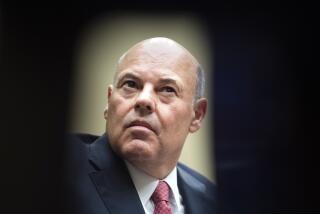Stamp acts
- Share via
FOR THOSE WONDERING what to do with those extra 2-cent stamps they bought last year after the last postal rate increase, fear not: The price of a stamp is going up another 2 cents today. It marks the fourth increase since 2001.
The near-annual price-hikes seem puzzling in the age of free e-mail. As people send fewer letters and pay more bills online, one would expect demand for postal services to decline. Lower demand typically leads to lower prices.
But this isn’t a typical situation. The U.S. Postal Service doesn’t function like most private businesses. And the total volume of U.S. mail is actually rising, as is the number of households receiving mail, a function of the growing American population and a steady increase in direct-mail solicitations (also known as junk mail). Yet it still holds true that the volume of first-class mail is falling, and this is the most labor-intensive kind of mail for the Postal Service. So why do we keep having to dig deeper into our wallets for stamps?
Partly it’s because the price of gas keeps going up, adding to transportation costs. But mostly it’s because the Postal Service is very generous to its unions.
As first-class mail declines, so does the revenue it generates. Most businesses react to declining revenue by laying off workers, especially because the decline means there’s less work to do. But layoffs are forbidden at the Postal Service under contracts with its four major unions. These contracts are so rigid that, for instance, they set nationwide pay scales for postal workers -- meaning a mail carrier in Fargo, N.D., gets the same paycheck as a counterpart in Los Angeles. That’s great for the employee in Fargo, where the cost of living is roughly 40% lower, but it’s quite unfair to workers in L.A.
The results are striking. Labor costs accounted for more than 78% of the Postal Service’s total expenses last year, compared to about 60% at UPS and only about 40% at Federal Express. The post office, unlike the other two, is entitled to deliver non-urgent first-class mail and has the exclusive right to use mailboxes. Government monopolies plus vigorous unions tend to equal a bad deal for consumers.
The Postal Service has come up with a marketing device to sweeten the pill of frequent stamp price hikes: the “forever” stamp, which will be good forever and can be bought at current prices. But hoarding stamps for the future doesn’t make a lot of economic sense. Neither does letting the Postal Service bureaucracy continually stick customers with the bill for its perennial failure to negotiate reasonable union contracts.
More to Read
Inside the business of entertainment
The Wide Shot brings you news, analysis and insights on everything from streaming wars to production — and what it all means for the future.
You may occasionally receive promotional content from the Los Angeles Times.










